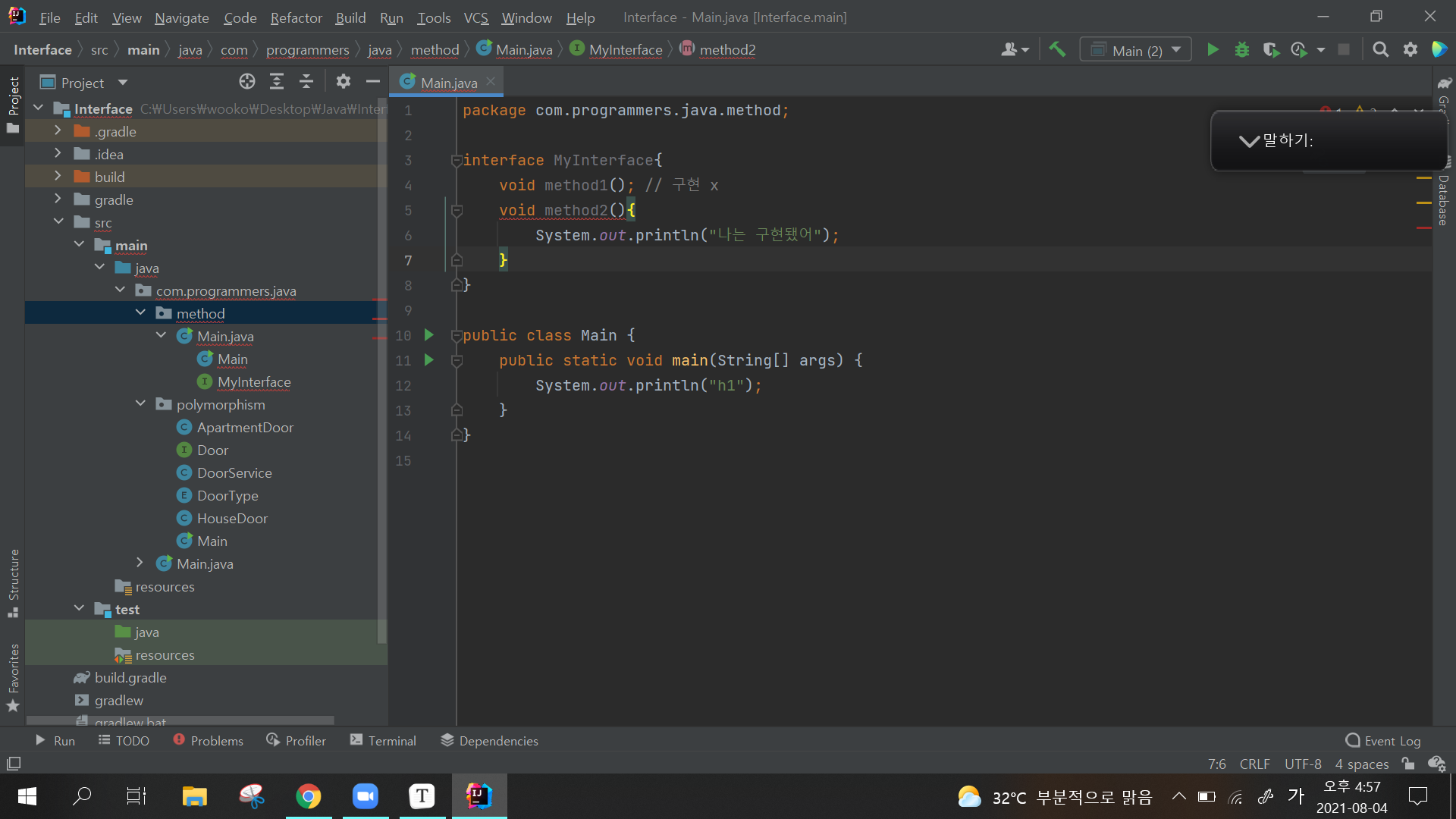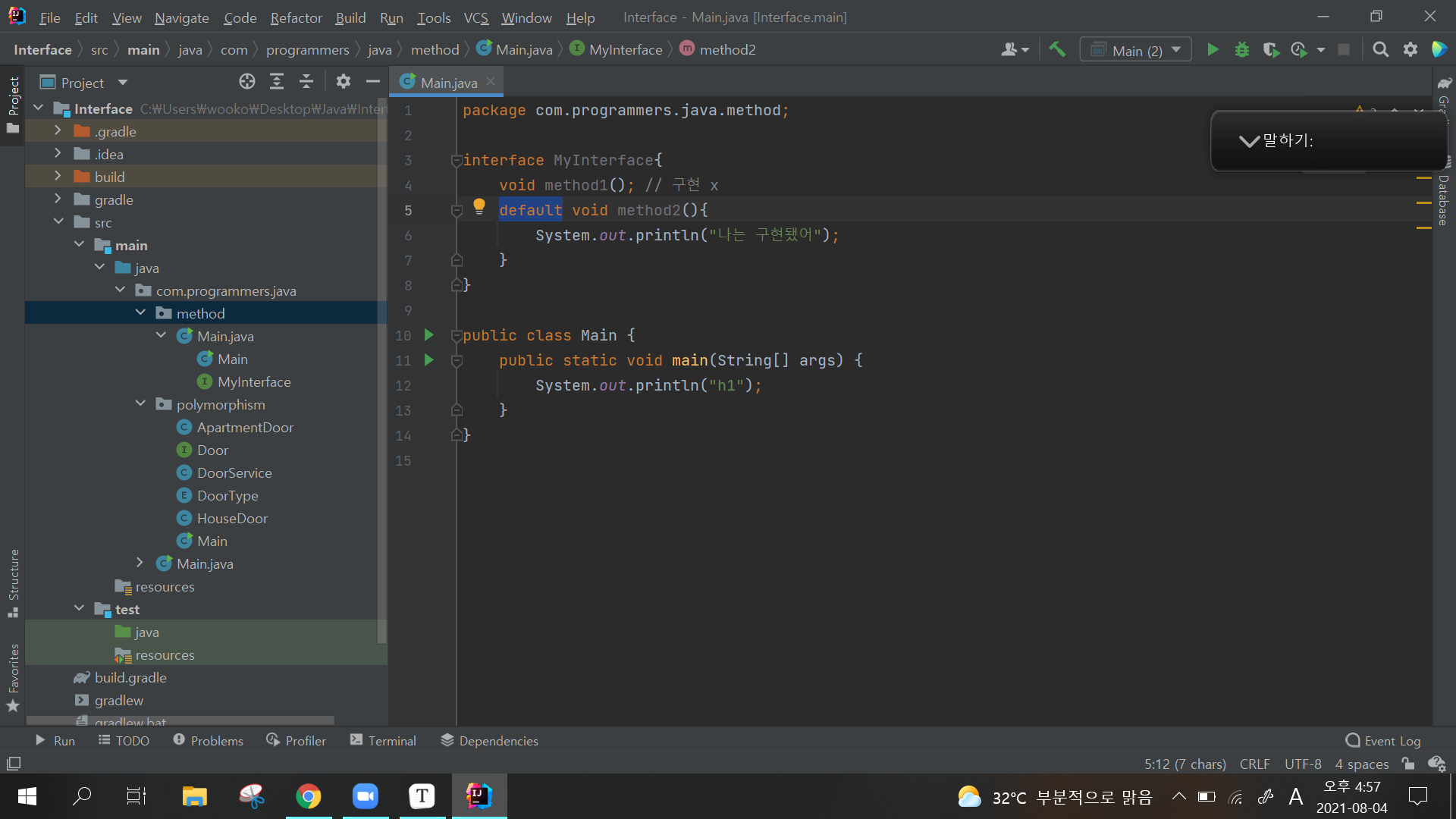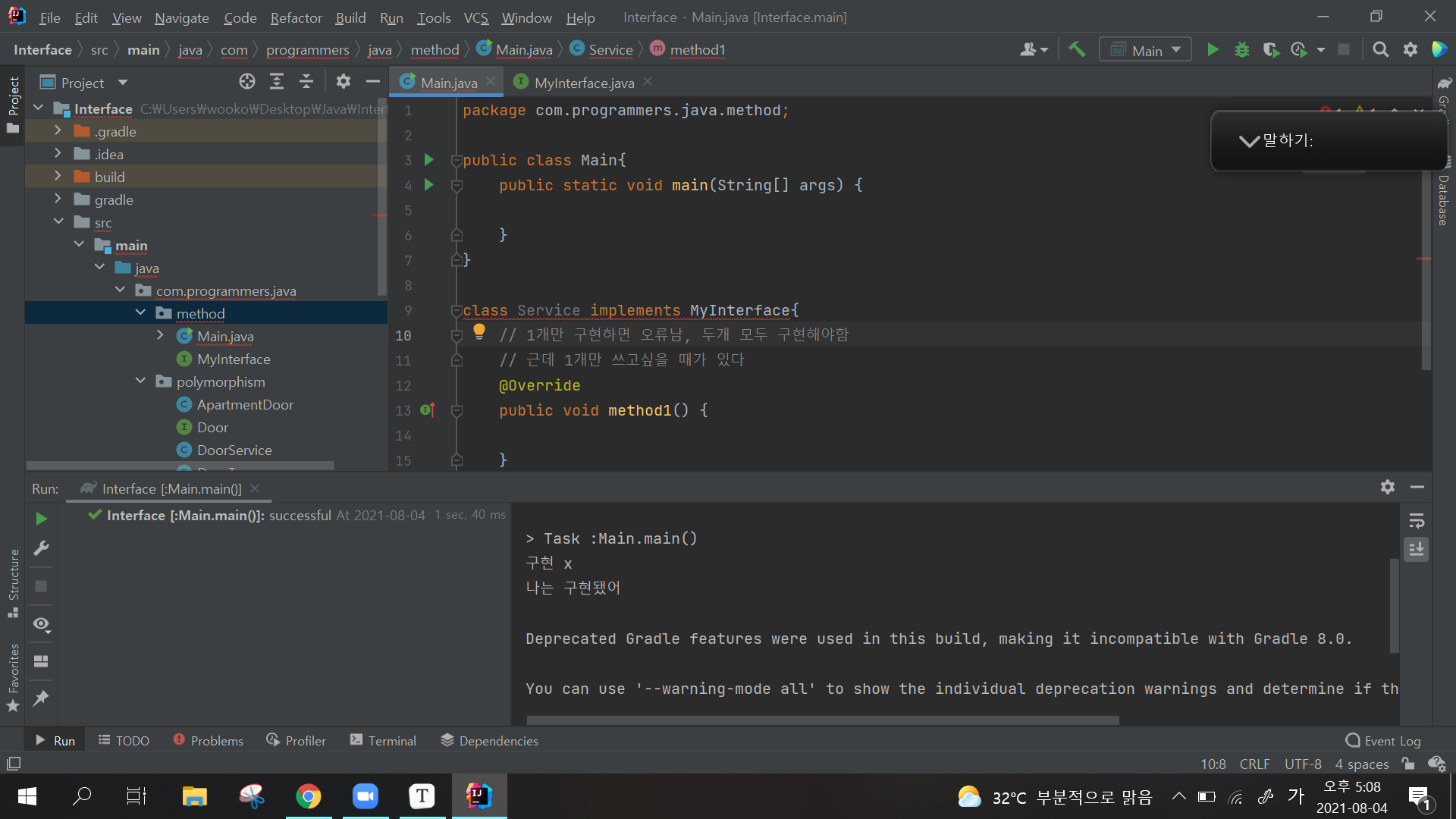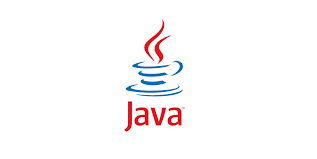- 인터페이스의 기능
-
구현을 강제하는 기능
-
'인터페이스란 모든 메소드가 추상메소드인 클래스'를 의미한다. 그래서 implements를 통해 구현된 클래스에서 추상메소드를 구체화 시킬 강제성이 존재한다
-
package com.programmers.java; import java.lang.*; interface Runnable{ // 인터페이스란 모든 메소드가 추상메소드인 클래스를 의미한다 void run(); /* void run(){ // 이 함수처럼 구현부가 있으면 오히려 인터페이스 생성이 안 됨 return null; } */ } public class Main implements Runnable{ public static void main(String[] args) { Runnable main = new Main(); main.run(); } @Override public void run() { // 이거 구현 안 하면 오류 System.out.println("hello world"); } }
-
-
다형성을 제공
-
package com.programmers.java; import java.lang.*; interface IamRunnable{ // 인터페이스란 모든 메소드가 추상메소드인 클래스를 의미한다 void iamRun(); } interface WeRunnable{ // 인터페이스란 모든 메소드가 추상메소드인 클래스를 의미한다 void weRun(); } public class Main implements IamRunnable, WeRunnable{ public static void main(String[] args) { Main m1 = new Main(); // Main으로 생성한다면 m1은 iamRun(), weRun() 모두 사용 가능 m1.iamRun(); m1.weRun(); IamRunnable m2 = new Main(); // 그러나 IamRunnable을 구현한 m2는 iamRun()만 사용 가능 m2.iamRun(); WeRunnable m3 = new Main(); // 마찬가지로 WeRunnable을 구현한 m3는 weRun()만 사용 가능 m3.weRun(); } @Override public void iamRun() { System.out.println("hello iam"); } @Override public void weRun() { System.out.println("hello we"); } } -
package com.programmers.java.polymorphism; //디자인 패턴 중 '팩토리 패턴'을 이용했음 public interface Door { void open(); } public class ApartmentDoor implements Door{ @Override public void open() { System.out.println("open the Apartment"); } } public class HouseDoor implements Door{ @Override public void open() { System.out.println("open the House"); } } public enum DoorType { ApartmentDoor, HouseDoor } public class Main { public static void main(String[] args) { // 팩토리패턴 //설정파일, config new Main().run(DoorType.ApartmentDoor); // 호스트 코드, 얘만 변경하면 수정됨 } private void run(DoorType doorType) { // 구현체에는 아무런 수정없이 변경 가능 Door door = getDoor(doorType); door.open(); } private static Door getDoor(DoorType type) { if (type == DoorType.ApartmentDoor) return new ApartmentDoor(); else return new HouseDoor(); } } -
package com.programmers.java.polymorphism; public interface Door { void open(); } public class ApartmentDoor implements Door{ @Override public void open() { System.out.println("open the Apartment"); } } public class HouseDoor implements Door{ @Override public void open() { System.out.println("open the House"); } } public enum DoorType { ApartmentDoor, HouseDoor } public class Main { public static void main(String[] args) { // 팩토리패턴 //설정파일, config new Main().run(DoorType.ApartmentDoor); // 호스트 코드, 얘만 변경하면 수정됨 } private void run(DoorType doorType) { // 구현체에는 아무런 수정없이 변경 가능 Door door = getDoor(doorType); door.open(); } private static Door getDoor(DoorType type) { if (type == DoorType.ApartmentDoor) return new ApartmentDoor(); else return new HouseDoor(); } } public class DoorService implements Door{ private Door door; // open에 의존한다, 의존성을 외부에 맡긴다 == 의존도를 낮춘다 // 인터페이스 같은 추상체와 결합을 하면 결합도를 낮출 수 있다 // 의존성을 외부로부터 전달받았다 == 의존성을 주입받았다 // 의존성 주입 == Dependency Injection(DI) public DoorService(Door door) { this.door = door; } @Override public void open() { door.open(); } }
-
-
결합도를 낮추는 효과
-
open에 의존한다, 의존성을 외부에 맡긴다 == 의존도를 낮춘다
-
인터페이스 같은 추상체와 결합을 하면 결합도를 낮출 수 있다
-
의존성을 외부로부터 전달받았다 == 의존성을 주입받았다
-
의존성 주입 == Dependency Injection(DI)
-
결국, Dependency Inversion 되었다
-
- 디폴트 메소드(Defaulat Method)
-
Java 8부터 메소드에 대한 개선이 존재했다
-
인터페이스가 구현체를 가질 수 있게 되었다. 인터페이스는 구현체를 가질 수 없지만 default 를 넣으면 가능해짐
-

-

-
package com.programmers.java.method; interface MyInterface{ void sayBye(); // 구현 x default void sayHello(){ System.out.println("나는 구현됐어"); } } public class Main implements MyInterface{ public static void main(String[] args) { new Main().sayBye(); new Main().sayHello(); // sayHello()는 이미 인터페이스에서 구현했기 때문에 // Main에서 따로 구현 안 해도 가능함, 물론 Main에서 sayHello()를 오버라이드 하는 것도 가능 } @Override public void sayBye() { System.out.println("구현 x"); //throw new RuntimeException(); } }
-
default method는 Adapter 역할 가능
-
인터페이스의 추상메소드 중에 원하는 것만 쓸려면 어떻게 하지?
-

-
위 사진처럼 인터페이스를 하위클래스에서 구현(implements)하게 되면 인터페이스에서 지정한 추상메소드들을 모두 쓰지않아도 하위클래스에서 오버라이드 해야함.
-
이런 낭비를 막기위해 Adapter를 이용한 해결법
-
package com.programmers.java.method; interface MyInterface { void method1(); // 구현 x void method2(); // 구현 x } public class InterfaceAdapter implements MyInterface{ @Override public void method1() { } @Override public void method2() { } } public class Main{ public static void main(String[] args) { } } class Service extends InterfaceAdapter{ // 어댑터는 상속받는 것에 주목하자 @Override public void method1() { System.out.println("hello world"); } }
-
-
default method : Adapter없이 해결 가능한 방법
-
이렇게 하면 다른 클래스를 상속받는 동시에 implements를 통해 인터페이스의 메소드 중에 마음에 드는 것만 구현해도 됨
-
package com.programmers.java.method; interface MyInterface { default void method1(){ } default void method2(){ } default void method3(){ } default void method4(){ } } public class Main{ public static void main(String[] args) { } } class Service extends Object implements MyInterface{ @Override public void method1() { System.out.println("hello world"); } }
-
-
적용하면 좋을 코드
-
walk()같은 공통 메소드에 대해 쉽게 처리할 수 있는 방법이 없을까 == default method 이용하면 됨 -
package com.programmers.java.method2; // default method 변경 전 코드 class Chicken implements Swimmable, Walkable{ @Override public void swim() { System.out.println("SWIM"); } @Override public void walk() { System.out.println("WALK"); } } class Eagle implements Walkable, Flyable{ @Override public void fly() { System.out.println("FLY"); } @Override public void walk() { System.out.println("WALK"); } } public class Main { } -
package com.programmers.java.method2; // default method 변경 후 코드 public interface Ability { static void sayGoodBye(){ System.out.println("say GoodBye~"); } } interface Flyable { default void fly(){ System.out.println("FLY"); } } interface Swimmable { default void swim(){ System.out.println("SWIM"); } } interface Walkable { default void walk(){ System.out.println("WALK"); } } class Chicken implements Swimmable, Walkable{ } class Eagle implements Walkable, Flyable{ } public class Main { public static void main(String[] args) { new Chicken().swim(); new Chicken().walk(); new Eagle().fly(); Ability.sayGoodBye(); } }
-
-
결론
-
인터페이스 추가만으로 내가 원하는 메소드만을 선택하고 수정하면서 기능을 확장할 수 있게 되었다
-
심지어 static 메소드를 가질 수 있게 됨
-
즉 인터페이스가 함수 제공자가 됨
-
메소드는 클래스에 종속된 함수를 의미한다
-
자바 8부터 '함수(Function)'이라고 불리는 것들이 생겨나기 시작함
-
-
-
-
- 함수형 인터페이스(Functional Interface)
-
추상메소드가 하나밖에 없는 메소드를 '함수형 인터페이스'라고 한다
static이나default메소드가 있어도 상관없이 '함수형 인터페이스'
-
@FunctionalInterface을 달아준다-
@FunctionalInterface에 있는 추상메소드를함수라고 부른다 -
package com.programmers.java.function; public interface MySupply { String supply(); } @FunctionalInterface public interface MyRunnable { void run(); // 추상메소드가 하나밖에 없는 메소드를 '함수형 인터페이스'라고 한다. } @FunctionalInterface interface MyMap{ // MyMap도 메소드가 총3개지만 2개는 구현화됐고, 1개만 추상메소드임으로 '함수형 인터페이스'라고 한다. void map(); default void sayHello(){ System.out.println("hello map"); } static void sayBye(){ System.out.println("bye map"); } } class Grerting implements MySupply{ @Override public String supply() { return "hello world"; } } class Hello implements MyRunnable{ @Override public void run() { System.out.println(new Grerting().supply()); } } public class Main { public static void main(String[] args) { new Hello().run(); } }
-
- 인터페이스 임시 생성하기
-
근데 함수형 인터페이스(Functional Interface) 사용해보니 불편함을 느끼게됨
-
그냥 main함수에
new MySupply.메소드()하면 안 될까?
-
해결 : 익명 클래스
-
익명클래스 사용해서 인터페이스의 인스턴스를 생성하고 구현함
-
package com.programmers.java.function; // 아까에 비해 굉장히 코드가 간결해진 것을 볼 수 있다. public interface MySupply { String supply(); } public class Main { public static void main(String[] args) { // 이름없는 클래스를 생성한다고 해서 '익명 클래스'라고 한다 new MySupply(){ @Override public String supply() { return "hello world"; } }.supply(); MyRunnable r = new MyRunnable() { @Override public void run() { MySupply s = new MySupply() { @Override public String supply() { return "heloooo~"; } }; System.out.println(s.supply()); } }; r.run(); } }
-
- Lambda Expression
-
익명 메소드를 사용해서 인터페이스의 인스턴스 생성을
간결하게표현하는 방법을람다 표현식이라고 한다
-
함수형 인터페이스(Functional Interface)에서만 사용 가능함
-
package com.programmers.java.function2; public class Main { public static void main(String[] args) { new MyRunnable(){ @Override public void run() { System.out.println("hello@@@@"); } }.run(); MyRunnable r1 = () ->{ //이것도 람다 표현식 System.out.println("hello world"); }; // 익명 메소드를 사용해서 표현하는 방법을 '람다 표현식'이라고 한다 MyRunnable r2 = () -> System.out.println("hello world"); // 한줄이라서 {}을 뺀 람다 표현식 r1.run(); r2.run(); } } -
package com.programmers.java.lamda2; @FunctionalInterface public interface MySupplier { String supply(); } @FunctionalInterface public interface MyMapper { int map(String s); } @FunctionalInterface public interface MyConsumer { void consume(int number); } @FunctionalInterface public interface MyRunnable { void run(); } public class Main { public static void main(String[] args) { MySupplier s = () -> "123456789"; //return 생략가능 MyMapper m = (str) -> str.length(); MyConsumer c = (number) -> System.out.println(number); MyRunnable r = () -> c.consume(m.map(s.supply())); r.run(); } }
-
-
메소드 레퍼런스
-
람다 표현식에서 입력되는 값을 변경없이 바로 사용하는 경우, 최종으로 적용될 메소드의 레퍼런스를 지정해주는 표현 방식
-
입력값을 바꾸지말라는 표현방식이 될 수 있다
- 만약에 수정이 빈번한 코드라면 위의 람다식을 추천한다
- 즉 다른 개발자의 개입을 차단함으로써 안정성을 얻을 수 있다.
-
public class Main { // 더욱 간결화된 람다 표현식 public static void main(String[] args) { MySupplier s = () -> "123456789"; //return 생략가능 MyMapper m = String::length; MyConsumer c = System.out::println; MyRunnable r = () -> c.consume(m.map(s.supply())); r.run(); } } -
package com.programmers.java.lambda3; import com.programmers.java.polymorphism.Main; import java.util.function.Consumer; import java.util.function.Predicate; public class Main2 { public static void main(String[] args) { new Main2().loop(10, new MyConsumer<Integer>() { @Override public void consume(Integer number) { System.out.println(number); } }); /*놀랍게도 위, 아래는 같은 표현이다*/ new Main2().loop(10, System.out::println); // filteredNumber()의 Predicate<Integer> p는 정수값이 들어왔을 때 boolean값을 반환한다 // 그래서 true or false를 결정할 조건문을 넣은 것 new Main2().filteredNumber(30, i -> i % 2 == 0, System.out::println); } void filteredNumber(int max, Predicate<Integer> p, Consumer<Integer> c){ for(int i=0; i<max; i++){ if(p.test(i)) c.accept(i); } } void loop(int n, MyConsumer<Integer> consumer){ for(int i=0; i<n; i++){ consumer.consume(i); } } }
-
- 결론
- 람다 표현식은 외운다고 해서 바로 쓸 수 있는 것이 아니므로 많이 보고 적용해보려고 노력하는게 중요하다

